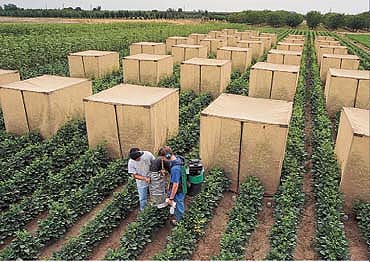All Issues
Lygus study validates treatment thresholds
Publication Information
California Agriculture 59(2):64-64. https://doi.org/10.3733/ca.v059n02p64
Published April 01, 2005
PDF | Citation | Permissions
Full text
Lygus bugs (Lygus hesperus) are a common insect pest in the San Joaquin Valley, affecting everything from cotton to pistachios and many other commodities. Kearney-based IPM advisor Pete Goodell conducted a study in 1996 of how this pest affects blackeye beans and discovered that the timing of the infestation has more to do with subsequent damage than the sheer number of pests.
In brown exclusion cages, varying densities of Lygus bugs (0, 20, 60 and 120) were released before and after flowering. The bugs were allowed to feed for 2 weeks. Yield data was collected and evaluated to determine impacts on quantity and quality. Field assistants collected Lygus bugs from the bean field with a vacuum sampler.
“We found that the timing of the infestation has more impact on yield than numbers,” Goodell says. “Beans are more sensitive to pressure from equivalent Lygus populations after flowering. Presumably, bean plants damaged early were able to compensate for any damage caused before bloom.”
Field assistants Tommy Koga and Jake Gregory sample for Lygus bugs in a blackeye bean plot with exclusion cages.
This study, supported by the UC Statewide IPM Program and Dry Bean Council, showed that treatment thresholds developed for older varieties were still valid for newer varieties.





